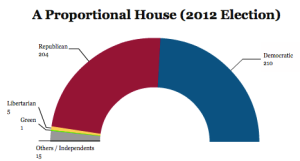A Proportional Electoral System vs. The Two Party’s
Friday, October 10, 2014 by Jonathan R. Gibbons in This graphic was found at suffragio.org
This graphic was found at suffragio.orgTired of Republicans vs. Democrats?
One way to severely limit two party dominance in American politics is to implement a proportional electoral system for the U.S. House of Representatives over our current plurality (winner-take-all) electoral system.
Currently, whichever candidate gets the mere majority of the votes wins the election. For example, suppose these candidates were running for the House and this was the result: 48% vote for Barack Obama, 45% vote for Mitt Romney, and 7% vote for Ralph Nader. Obama wins.
In a proportional system, for an election to the House, the party that received 48% of the vote would receive 48% of the seats in the House. The party that received 45% would receive 45% of the seats in the House… and so on. This is the system used by the majority of advanced democracies and they have thriving multiple party systems. If you are among the 7% who voted for Ralph Nader, you would still receive a level of representation in your own government.
Conversely, with our current system, the 52% of people who didn’t vote for Obama are not represented in the U.S. House. That’s more than the majority! This sort of reform would require a constitutional amendment, but it’s one of the root structural causes of American frustration with their government.
Sources:
Colomer, Josep M. 2005. “It’s Parties That Choose Electoral Systems (or, Duverger’s Laws Upside Down).” Political Studies 53, no. 1: 1-21.
Da Silva, VirgÃlio Afonso. 2006. “Duverger’s Laws: Between social and institutional determinism.” European Journal Of Political Research 45, no. 1: 31-41.
Schaffner, Brian F. 2010. Politics, Parties, And Election In America. Amherst: University of Massachusetts. Wadsworth Cengage Learning, 39-41.



























